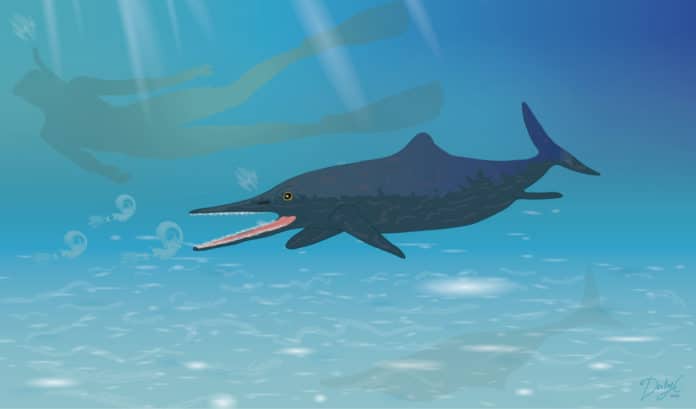Scientists from McGill University and the State Museum of Natural History Stuttgart in Germany have identified Hauffiopteryx Altera as a new species of Ichthyosaurs, a group of tuna-shaped reptiles that inhabited Earth’s seas during the Mesozoic Era.
Like dolphins, ichthyosaurs underwent profound adaptions to aquatic environments, including limbs transformed into flippers, a dorsal fin, and a tail fin.
Dirley Cortés, a graduate student under the supervision of Prof. Hans Larsson at McGill’s Redpath Museum and co-author of the study published in Palaeontologica Electronica, said, “Although the marine ecosystems are generally similar across Europe during this time, we are finding there are some rare and possibly endemic species. This finding will have a lot to say about how these ancient ecosystems functioned.”
Scientists retrieved the fossils in the Posidonia Shale, an Early Jurassic geological formation located at the axis of Austria, the Czech Republic, Germany, Luxembourg, the Netherlands, and Switzerland. Quarried for over 200 years, the site has yielded thousands of spectacularly preserved ichthyosaur skeletons ranging between two and more than ten meters in length and representing seven species. Fossilized soft tissues, stomach contents, and embryos were also discovered.
Quarried for over 200 years, the site has yielded thousands of spectacularly preserved ichthyosaur skeletons ranging between two and more than ten meters in length and representing seven species. Fossilized soft tissues, stomach contents, and embryos were also discovered.
Erin Maxwell, curator of fossil aquatic vertebrates at the State Museum of Natural History Stuttgart and lead author of the study, said, “We were surprised to discover that this small dolphin-sized specimen, collected decades ago, is a new species. There is quite a lot of diversity still waiting to be discovered in our vast museum collections.”
Journal Reference:
- Erin E. Maxwell et al. Revision of Hauffiopteryx. DOI: 10.26879/937
